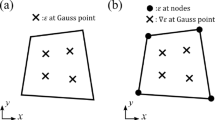Abstract
A model has been developed for calculating the anisotropic magnetic properties of soft magnetic materials with the objective of accounting for variations in permeability in textured materials. The model in its current form takes account of the rotation of the magnetization direction in each domain of a textured polycrystal and, thus, is applicable to large applied fields. The magnetization direction is determined by minimizing the sum of the magnetocrystalline anisotropy energy and the energy of interaction between the applied field and local magnetization. Examples are given of the application to idealized textures, such as fiber textures, in which all grains share a common axis parallel to the sheet normal (ND). The cube fiber (〈100〉‖ND) has the highest permeability at any applied field, followed by a randomly oriented polycrystal, with the gamma fiber (〈111〉‖ND) having the lowest permeability. Two further examples are given of textured steel sheets, often referred to as “nonoriented electrical steels,” intended for use as laminations in rotating electrical machinery. In one case, the two samples show that a random texture is preferable to one in which the rolling texture is retained. The second example demonstrates the importance of a particular texture component, the Goss or 〈001〉{110}, for producing an anisotropic permeability.
Similar content being viewed by others
References
E.C. Stoner and E.P. Wohlfarth: Phil. Trans. R. Soc., 1948, vol. A240, pp. 599–642.
E.J. Hilinski, S.R. Goodman, and A.D. Rollett: Proc. 17th Conf. on Properties and Applications of Magnetic Materials, U.S. Steel, Pittsburgh, PA, unpublished research, 1998.
K. Eloot, J. Penning, and J. Dilewijns: J. Phys. IV France, 1998, vol. 8, pp. 483–86.
G. Lyudkovsky, A.G. Preban, and J.M. Shapiro: J. Appl. Phys., 1982, vol. 53, pp. 2419–21.
J.P. Anderson: Metall. Mater. Trans. A, 1995, vol. 26A, pp. 1535–42.
P.A. McCormick and N.H. Scott: Hard & Soft Magnetic Materials with Applications Including Superconductivity, ASM INTERNATIONAL, Metals Park, OH, 1987, pp. 87–90.
B. Szpunar and J. Szpunar: IEEE Trans. Magn., 1984, vol. 20, pp. 1490–92.
H. Bunge: Z. Metall., 1985, vol. 76, p. 457.
M. Birsan and J.A. Szpunar: Mater. Sci. Forum, 1994, vols. 157–162, pp. 1543–50.
M. Birsan and J.A. Szpunar: in ICOTOM-11, Z. Liang, L. Zuo, and Y. Chu, eds., International Academic Publishers, Beijing, 1996, vol. 2, pp. 689–93.
M. Birsan and J.A. Szpunar: in ICOTOM-11, Z. Liang, L. Zuo, and Y. Chu, eds., International Academic Publishers, Beijing, 1996, vol. 2, pp. 695–702.
U.F. Kocks: 8th Int. Conf. on Textures of Materials (ICOTOM-8), J.S. Kallend and G. Gottstein, eds., TMS, Warrendale, PA, 1988, pp. 31–36.
K. Honda and S. Kaya: Sci. Rep. Tohoku Univ., 1926, vol. 15, p. 721.
G. Lyudkovsky and J.M. Shapiro: J. Appl. Phys., 1985, vol. 57, pp. 4235–37.
H.J. Oguey: in Magnetism and Metallurgy, A.E. Berkowitz and E. Kneller, eds., Academic Press, New York, NY, 1969, pp. 190–246.
S. Matthies and G.W. Vinel: Phys. Status Solidi, 1982, vol. B112, pp. K111-K114.
S. Matthies, H.-R. Wenk, and G.W. Vinel: J. Appl. Cryst., 1988, vol. 21, pp. 285–304.
J.S. Kallend, U.F. Kocks, A.D. Rollett, and H.-R. Wenk: Mater. Sci. Eng., 1991, vol. A132, pp. 1–11.
A. Coombs: J. Phys. IV France, 1998, vol. 8, pp. 475–82.
J.W. Shilling and J.G.L. Houze: IEEE Trans. Magn., 1974, vol. M10, pp. 195–23.
D. Kinderlehrer and L. Ma: Physica B, 1997, vol. 233, pp. 376–80.
D. Kinderlehrer and L. Ma: J. Nonlinear Sci., 1997, vol. 7, pp. 101–28.
Author information
Authors and Affiliations
Rights and permissions
About this article
Cite this article
Rollett, A.D., Storch, M.L., Hilinski, E.J. et al. Approach to saturation in textured soft magnetic materials. Metall Mater Trans A 32, 2595–2603 (2001). https://doi.org/10.1007/s11661-001-0049-2
Received:
Issue Date:
DOI: https://doi.org/10.1007/s11661-001-0049-2




